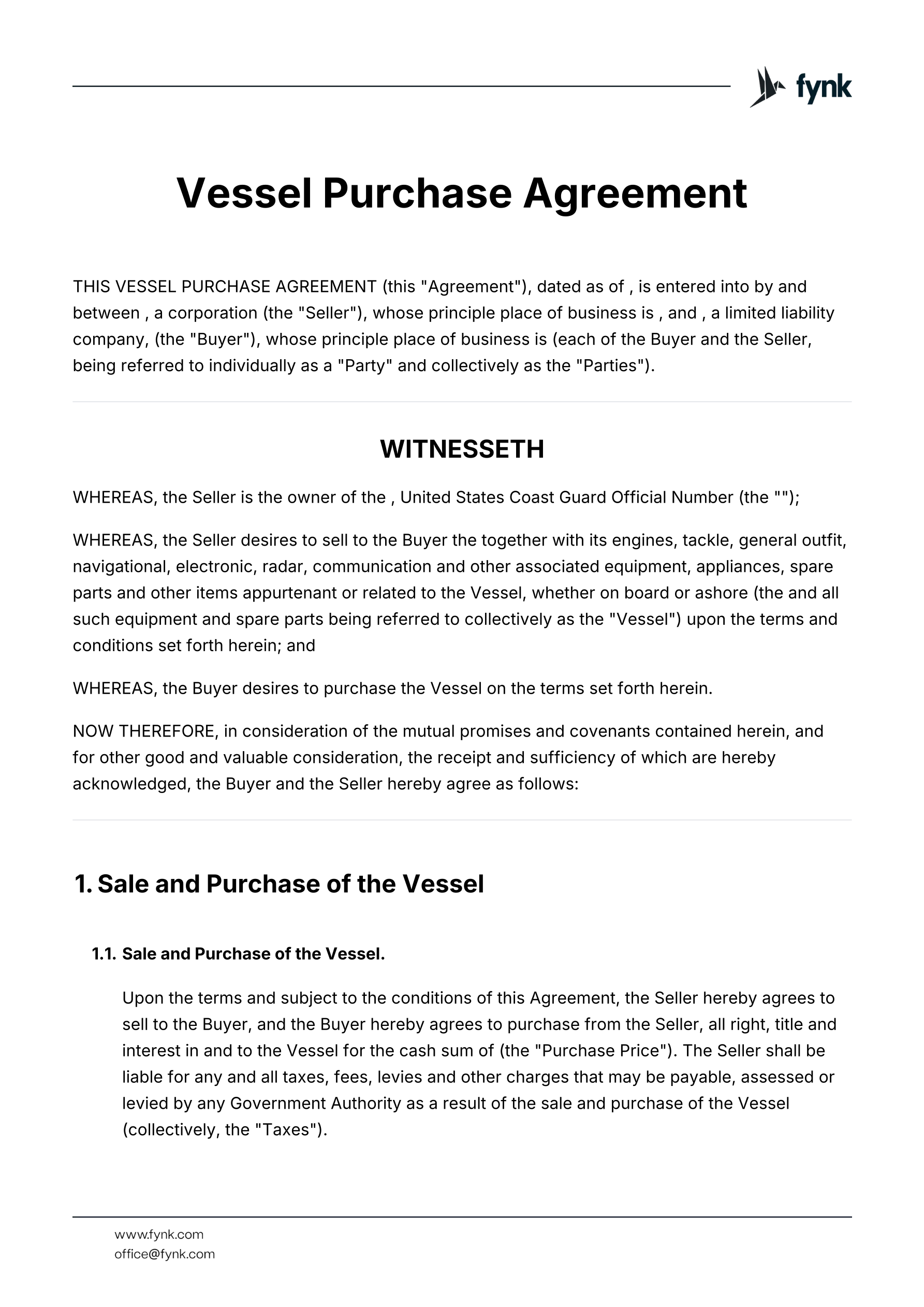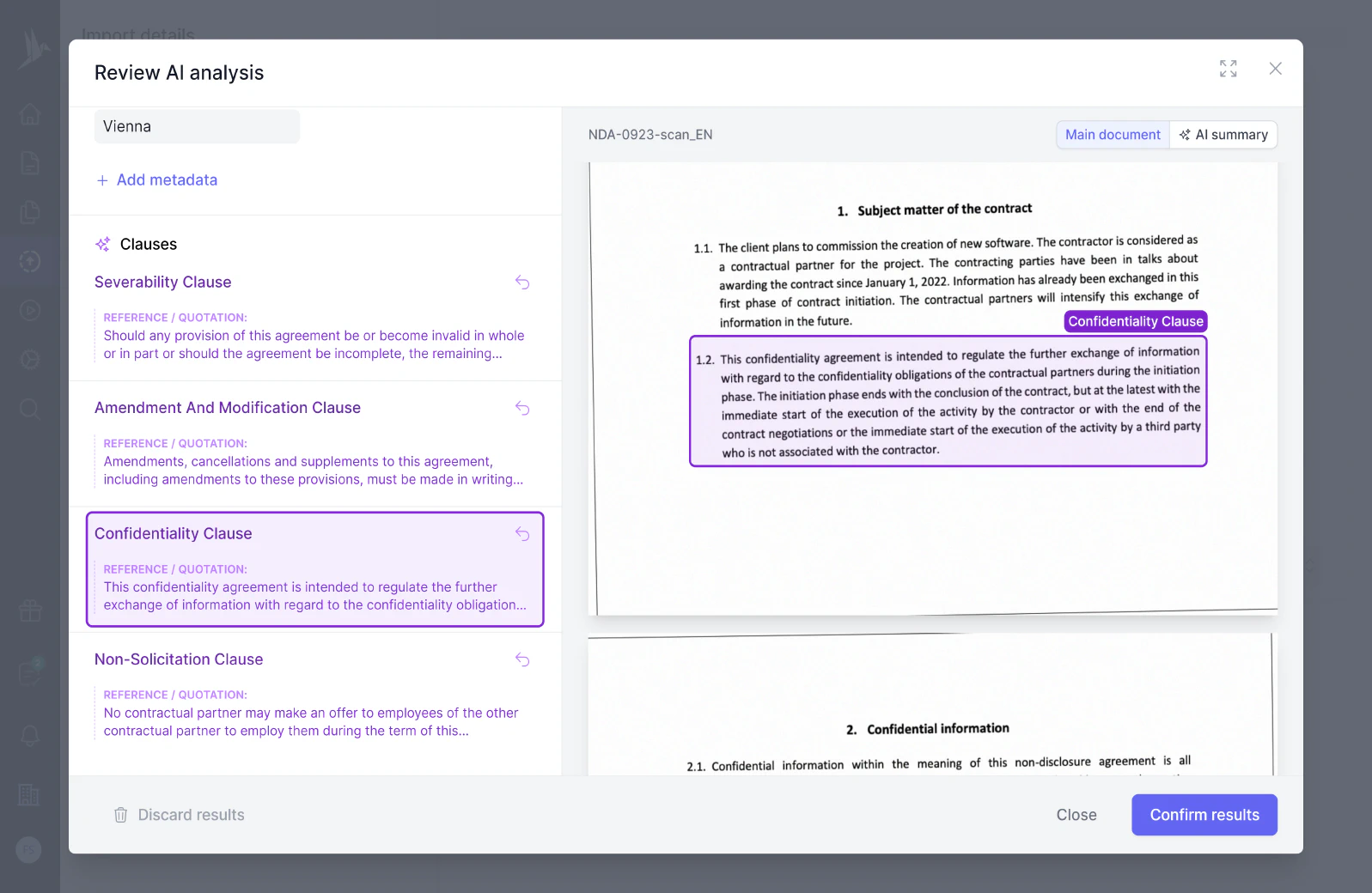
Boat Sale Agreement Template (Vessel Purchase Contract)
Transfer vessel ownership smoothly with a clear boat sale agreement covering price, deposits, closing, and risk of loss.
An indemnity clause is a contractual provision where one party agrees to compensate the other for certain costs and liabilities that may arise due to specified events or actions. This clause is designed to allocate risk by holding one party responsible for losses incurred by the other, providing financial protection in situations such as breaches of contract, negligence, or legal claims.
In view of the premises described above, it is necessary to create a formal and standardized regulation for Eletrobras companies, both for the use of the Indemnity Contract, whose draft is an integral part of this policy, in the form of Appendix I, and for the activation of D&O Insurance.
3.3 Indemnity Requests 3.3.1 Beneficiaries who wish to receive the benefit in relation to a certain claim that seeks to hold them responsible for acts practiced in the regular exercise of their functions in the Company (or other positions that the beneficiary assumes in subsidiaries of the Company or other entities for which the Company has indicated them for a certain position) and that involves or may involve conviction of the beneficiary to any penalty, fine or constriction, may submit to the Company requests for indemnification, advance and/or reimbursement of costs and expenses related to their defense or manifestation (such as testimonies or clarifications of any nature) in relation to the claim in question (“Indemnity Request” or “Request”). 3.3.2 The Requests must be sent in the form and terms provided for in the Indemnity Contract simultaneously with (i) Vice Presidency of Finance and Investor Relations, (ii) Legal Vice Presidency and (iii) Vice Presidency of Governance, Risks and Compliance, together with all documents and information available to the beneficiary related to the claim (including a copy of the letter, summons, notification, assessment or summons received, and other documents that are available), being certain that the Company may request, from the beneficiary, any supplements of information and documents, which must be presented to the Company within the period indicated by it.
3.5 Indemnity Contract 3.5.1 The Company shall analyze whether the Indemnity Request is covered by the Indemnity Contract in the following cases: (a) negative by the insurer responsible for the D&O Insurance; (b) absence of response from the insurer about the coverage in a reasonable time to enable the processing of the Request in compliance with the term in progress to comply with the obligation or exercise the right of defense; (c) need to advance expenses to ensure the exercise of the beneficiary's broad defense, pursuant to sub-item 3.7.3 below; (d) amount to be indemnified less than the amount of the deductible provided for in the respective D&O Insurance; or (e) amount to be indemnified exceeds the amount of the D&O Insurance coverage.
3.6 Analysis of Indemnity Requests 3.6.1 Upon receipt of a Request, the resolution on the granting of the indemnity will be the responsibility of the Legal Vice Presidency and the Vice Presidency of Governance, Risks and Compliance, observing that, in the cases of sub-item 4.2.1.4, the admissibility decision must be submitted to the review of the Board of Directors, having previously heard CAAJ in the form of sub-item 4.3. 3.6.2 The Request that is inadmissible by the Legal Vice Presidency and Vice Presidency of Governance, Risks and Compliance will not be submitted for review by the Board of Directors, even if it is any of the cases of sub-item 4.2.1.4, without prejudice to the provisions of sub-item 4.2.1.10 ofthis policy.
6.1 The manifestations and resolutions of the Board of Directors, CPES, CAAJ and Temporary Indemnity Committee related to the attributions portrayed in this policy must be taken by an absolute majority of votes, except for any matters that, by law or by the Articles of Incorporation, require a qualified quorum.
6.2 Unless otherwise provided in the Indemnity Contract, all notices and communications to the Company related to the policy and the Indemnity Contract must be sent to the following emails: [email protected], [email protected] and [email protected], with proof of delivery.
Letter of Indemnity 1. General 1.1. In this Letter of Indemnity: “Administrative Proceeding” - a proceeding pursuant to Chapters H3 (Financial Sanction by the Securities Authority), H4 (Administrative Enforcement Measures by the Administrative Enforcement Committee) or I1 (Arrangement for the Avoidance of Initiating Proceedings or for the Termination of Proceedings that are Conditional) of the Securities Law;
The Company hereby undertakes to indemnify you for any liability or expense, as detailed below, imposed upon and/or incurred by you due to any action that you performed and/or shall perform in your capacity as an Officer of the Company, subject to the provisions and limitations detailed in this Letter of Indemnity.
Liabilities and Expenses Subject to the Indemnity The indemnity shall apply for the following liabilities and expenses: 3.1. A financial liability imposed upon you to the benefit of another person by a judgment, including a judgment issued in a settlement and/or an arbitrator’s award approved by a court, provided the maximum indemnity amount does not exceed the amount determined by the board of directors to be reasonable under the circumstances, which is detailed in section 5 below, and provided such financial liability relates to one or more of the events which in the opinion of the board of directors are foreseeable in light of the Company’s activities in practice at the time of giving this undertaking, or any part thereof or anything relating thereto, which are detailed in section 6 below.
Indemnity as foregoing in section 3.1 shall not apply to any act that constitutes: 3.6.1. Breach of fiduciary duty towards the Company or its subsidiary or associated company or other entity, unless you acted in good faith and had reasonable grounds to believe that such act would not harm the Company or its subsidiary or associated company or other entity; 3.6.2. Intentional or reckless breach of duty of care, except if negligent only; 3.6.3. Any action by you made with the intention to illegally derive personal profit; 3.6.4. Fine, civil fine, financial sanction or forfeit imposed upon you.
“Indemnity” means this written Indemnity;
In this Indemnity: 2.3. the headings are for the purpose of convenience and reference only and shall neither be used in the interpretation of nor modify nor amplify the terms of this Indemnity nor any of its clauses; 2.4. words importing: 2.4.1. any one gender include the other of masculine, feminine and neuter; 2.4.2. the singular include the plural and vice versa; and 2.4.3. natural persons include created entities (corporate or unincorporate) and the state and vice versa; 2.5. if any provision in a definition is a substantive provision conferring rights or imposing obligations on any Party, notwithstanding that it is only in the definition clause, effect shall be given to it as if it were a substantive provision in the body of this Indemnity; 2.6. when any number of days is prescribed in this Indemnity, same shall be reckoned exclusively of the first and inclusively of the last day unless the last day falls on a day which is not a Business Day, in which case the last day shall be the next succeeding Business Day; 2.7. the use of any expression in this Indemnity covering a process available under English law shall, if any of the Parties is subject to the law of any other jurisdiction, be construed as including any equivalent or analogous proceedings under the law of such other jurisdiction; 2.8. the discharge or termination of this Indemnity shall not affect those provisions of this Indemnity which expressly provide that they will operate after such discharge or termination or which of necessity must continue to have effect after such discharge or termination, notwithstanding that the clauses themselves do not expressly provide for this; 2.9. the rule of construction that a contract shall be interpreted against the Party responsible for the drafting or preparation of the contract, shall not apply; 2.10. any reference in this Indemnity to a Party shall include a reference to that Party’s assigns expressly permitted under this Indemnity and, if such Party is liquidated, or is sequestrated or business rescue proceedings have commenced in respect of such Party, be applicable also to and binding upon that Party’s liquidator, trustee or business rescue practitioner, as the case may be;
5. INDEMNITY 5.1. Sankaty hereby indemnifies, and shall keep indemnified until the Termination Date, Grindrod, to the extent of the Sankaty Shareholding Percentage of each and every Sankaty Indemnified Payment, in each case, subject to the conditions set forth in clause 6.2 below. 5.2. Grindrod hereby indemnifies, and shall keep indemnified until and after the Termination Date, Sankaty, to the extent of the Grindrod Indemnified Amount.
. INDEMNITY IS NOT AFFECTED; CONDITIONS TO INDEMNITY 6.1. Each Party’s obligations under this Indemnity are absolute and unconditional (other than the conditions set forth in clauses 6.2 and 6.3 below), and shall not be released, discharged, limited or affected by: 6.1.1. the incapacity or lack of power, authority or legal personality of or dissolution or change in the members or status of any party to any of the Finance Documents; or 6.1.2. IVS Bulk or any of its subsidiaries being liquidated, wound-up (whether provisionally or finally), having business rescue proceedings commenced against it, being placed under supervision, business rescue or suffering any similar legal disability.
3 Guarantee and Indemnity In consideration of, amongst other things, the agreement of the Banks to enter into the Supplemental Agreement and the several agreements of the Banks to maintain the facilities under the Loan, the Guarantor:- 3.1 irrevocably and unconditionally guarantees to the Security Trustee, as trustee for the Finance Parties, to discharge on demand the Borrowers’ Obligations, including Interest from the date of demand until the date of payment, both before and after judgment; and 3.2 agrees, as a separate and independent obligation, that, if any of the Borrowers’ Obligations are not recoverable from the Guarantor under Clause 3.1 for any reason (including, without limitation, by reason of the Borrowers’ Obligations being or becoming unenforceable, invalid, void or illegal), the Guarantor will be liable to the Security Trustee, as trustee for the other Finance Parties, as a principal debtor by way of indemnity for the same amount as that for which the Guarantor would have been liable had those Borrowers’ Obligations been recoverable and agrees to discharge its liability under this Clause 3.2 on demand together with Interest from the date of demand until the date of payment, both before and after judgment.
The purpose of this Indemnity Policy (“Policy”) is to set forth directives, requirements, limits and procedures to grant the indemnity commitment to the following Beneficiaries (“Indemnity Commitment”):
5.1 INDEMNITY INSTRUMENT The Indemnity Commitment will be delivered upon execution of Indemnity Instruments, observing the following: (i) Indemnity Instruments to be executed by the Company or any of its Wholly-Owned Subsidiaries , as applicable, with Administrators of the Company and the Wholly-Owned Subsidiaries, on the date of approval of this Policy, and new Administrators upon their election or hiring, as applicable, without the need for specific approval from any body and regardless of whether there is a Claim or potential Claim at the time of execution of the Indemnity Instrument, substantially in the form of Exhibit I, (adjustments that may be necessary on a case-by-case basis are permitted, provided that they do not change the rights and obligations contained in the aforementioned template); (ii) Indemnity Instruments to be signed in relation to any Claim or potential Claim involving (a) a Beneficiary who is not an Administrator of the Company or its Wholly-Owned Subsidiaries; (b) Former Administrator who does not have a signed Indemnity Instrument; or (c) Administrators of Subsidiaries with Participation of External Partners, Entities or Investees appointed by Braskem, if such companies fail to grant the Indemnity Commitment, observing the requirements for its execution, as provided for in item 5.3.2 below, substantially in the form of Exhibit II, (adjustments that may be necessary on a case-by-case basis are permitted, provided that they do not change the rights and obligations contained in the aforementioned template).
The Indemnity Commitment seeks to ensure, according to this Policy and within the legal, regulatory and ethical limits, legal and equity protection to the Beneficiaries, with the purpose of attracting and retaining qualified professionals.
“(xvii) “Indemnity Escrow Equity” means a number of Acquiror Shares, Substitute Options and Substitute RSUs equal to, in the aggregate, the Indemnity Escrow Number.
On May 10, 2022, Malachite Innovations, Inc. (the “Company”) entered into a securities purchase agreement (the “Indemnity National Agreement”) with Indemnity National Insurance Company (“Indemnity National”) providing for the issuance and sale by the Company to Indemnity National of (i) 13,333,333 shares of the Company’s common stock (the “Indemnity National Shares”) at a price of $0.15 per share and (ii) warrants to purchase up to an additional 13,333,333 shares of the Company’s common stock (the “Indemnity National Warrant”, and the shares issuable upon exercise of the Warrant, the “Indemnity National Warrant Shares”) at a price of $0.60 per share. After deducting for fees and expenses, the aggregate net proceeds from the sale of the Indemnity National Shares and Indemnity National Warrant is approximately $1,950,000.
Indemnity is a contractual agreement between two parties, where one party agrees to compensate the other for certain damages, losses, or liabilities that may arise during the course of their relationship. It acts as a protection mechanism, ensuring that the indemnified party is financially protected against specific risks. Indemnity clauses are commonly found in a wide range of contracts and are used to allocate risk between the contracting parties.
You should consider including an indemnity clause in a contract when there are potential risks or liabilities that need to be specifically managed. This may include situations where:
Writing an indemnity clause involves clearly specifying the scope of the indemnity, the parties involved, and the conditions under which the indemnity will be triggered. Here are some key components to consider when drafting an indemnity clause:
Identification of Parties: Clearly state who is the indemnitor (the party providing indemnity) and who is the indemnitee (the party receiving indemnity).
Scope of Indemnity: Define what type of losses, damages, or claims are covered. This could include legal fees, third-party claims, or specific types of damages.
Conditions and Limitations: Specify any conditions under which the indemnity will apply, and clearly outline any limitations on the indemnitor’s liability.
Procedure for Claims: Include procedures for making and managing indemnity claims, detailing the necessary notifications and steps to be taken by both parties.
Example:
"The Contractor agrees to indemnify, defend, and hold harmless the Company against all claims, liabilities, losses, and expenses, including reasonable attorney's fees, arising out of or related to the Contractor's performance of the Work under this Agreement, except to the extent such claims arise from the Company's negligence or intentional misconduct."
Indemnity clauses are prevalent in many types of contracts, particularly where risk management is a critical concern. Some common contracts that typically contain indemnity provisions include:
Including a well-drafted indemnity clause in these contracts helps in outlining clear terms of protection and responsibility, thus minimizing disputes and potential financial liability.
These templates contain the clause you just read about.

Transfer vessel ownership smoothly with a clear boat sale agreement covering price, deposits, closing, and risk of loss.

Customize a secured business loan contract covering repayment, collateral, covenants, and default terms to protect both lender and borrower.

Define rent, responsibilities, and terms between landlords and tenants for leasing business properties.

Define custodian duties, reporting, liabilities, and compliance for safeguarding investment assets.

A clear energy services agreement template for engaging a service provider to manage operations, finance, and compliance.

A clear retainer agreement defining scope, hours, pay, confidentiality, non-solicitation, and contractor status for post-employment consulting.
Dive deeper into the world of clauses and learn more about these other clauses that are used in real contracts.
The independent consideration clause refers to the nominal payment or action that is separately identified and provided by one party to another in exchange for specific contractual promises, ensuring the agreement is enforceable under contract law. This element is crucial because it demonstrates that a contract offer has been made and accepted with mutual obligations, adding to the validity and binding nature of the agreement.
An independent contractor relationship clause defines the working relationship between parties, specifying that the contractor operates autonomously and is not an employee of the hiring party. This clause clarifies that the contractor is responsible for their own taxes, insurance, and adherence to laws, and it delineates the absence of benefits typically associated with employment.
An independent contractor clause establishes the relationship between the parties, specifying that the contractor is not an employee and will work independently, managing their own schedule and methods of completing the work. This clause typically outlines the responsibilities of the contractor, their lack of entitlement to employee benefits, and their obligation to pay their own taxes.
Try our AI contract analysis and extract important clauses and information from existing contracts.
< <
Fill out the form and we will get in touch with you to give you a personal, customized demo of fynk.
Greetings!
I'm Markus, co-founder of fynk. After you've submitted the form, I'll swiftly get in touch with you.
Also, right after you submit your details, you can pick a time that works best for you for our meeting.

